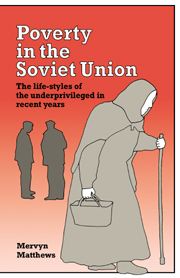Postscript: Twelve theses on Soviet poverty
Published online by Cambridge University Press: 30 October 2009
Summary
The existence of poverty some six and a half decades after the Revolution must be counted as a major failure of the Soviet experience. The central aims of the Bolshevik Revolution were not only the rapid establishment of a homogeneous society, but also the eradication of want. This failure has exceedingly negative implications for the practice of Marxism–Leninism elsewhere.
The condition of the poor in the Soviet Union has been sadly neglected by Western observers, not least on account of the stringent Soviet ban on reporting. It is noteworthy that words like ‘poverty’ and ‘slum’ cannot be used in official sources to refer to any social condition in the USSR, and no official estimates are available. The contrast with the flood of information on poverty in other lands is stark indeed. Soviet poverty needs to be monitored by indirect methods; the difficulties of doing so should not be allowed to halt further research. The inability of Soviet power to eradicate poverty requires adequate illustration, both for Soviet citizens and the public abroad.
Our analysis of Soviet data suggests that in the late seventies some two-fifths of the non-peasant labour force earned less than the sum needed to achieve a minimum level of subsistence proposed by Soviet scholars for small urban families. The incidence of poverty among larger families, peasants and pensioners was undoubtedly higher. Comparisons are hazardous, but about a ninth of the population of the USA was reported to be under the poverty ‘cut-off’ level in 1979. Moreover, a tentative cost comparison of the official US and ‘academic’ Soviet poverty thresholds indicates that the Soviet one is much lower. Thus the application of American poverty standards to Soviet society would result in a far larger Soviet poverty contingent.
[…]
- Type
- Chapter
- Information
- Poverty in the Soviet UnionThe life-styles of the underprivileged in recent years, pp. 176 - 179Publisher: Cambridge University PressPrint publication year: 1986

